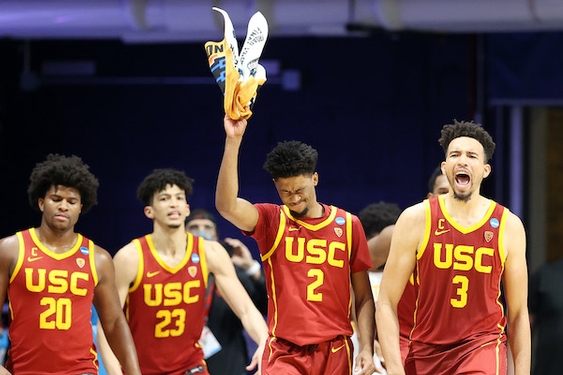Before he pulled up from the top of the key two weeks ago, Isaiah Mobley wasn’t exactly lighting it up from long range. The USC sophomore hadn’t hit a three-point shot since Feb. 20. Entering the Pac-12 tournament, he’d only attempted 24 all season, making seven.
As USC (24-7) heads to the Sweet 16 for the first time in 14 years, it’s not exactly known for its three-point prowess, either. No team remaining in the NCAA tournament relied less on threes this season than the Trojans, who made about a third of those attempted.
That is, until Mobley pulled up against Utah and opened the floodgates. Since then, USC is hitting from long range at a pace it hasn’t all season. In their four postseason games, the Trojans have shot 44.3% from deep (31 of 70). Mobley has made eight of his last 10 three-point attempts.
USC would prefer to maintain that pace Sunday when it faces Oregon, one of the best three-point shooting teams in the nation, in Indianapolis.
A few hours later, USC also made 11 threes and crushed third-seeded Kansas 85-51.
“The three-point line is extremely important,” USC coach Andy Enfield said. “Oregon shoots it at a high level. At least they have been lately. You saw that against Iowa. They made a lot of threes. They were out in transition. They drove the ball at a high level as well. They really spread the floor, especially when they’re playing five guards at the same time.”
Ducks point guard Will Richardson has been especially lethal since March began, hitting from deep at a 54% clip. Chris Duarte, who hit 43% of his threes this season, is no slouch either.
But in their last meeting, it was USC that outgunned Oregon’s backcourt. Tahj Eaddy made six threes. The Trojans got off to a 15-0 start and never looked back, beating Oregon 72-58.
Another strong showing from deep would go a long way toward USC earning its first Elite Eight berth since 2001. But while Oregon would probably prefer Sunday’s game to become a three-point shooting contest, both teams understand that USC has its own advantages to exploit. Namely, its size.
The Ducks’ most common lineup includes five forwards and guards, none over 6 feet 6. Four of the Trojans’ five starters are at least that tall, with Evan Mobley checking in at 7 feet and brother Isaiah at 6-10.
“They present a lot of problems defensively with the talent and athleticism they have at all positions,” Oregon coach Dana Altman said. “And then the boards are a concern because of their size.”
It’s been eight years since Andy Enfield took a No. 15 seed to the Sweet 16 and put Florida Gulf Coast on the map.
“But when you reminisce a little bit,” Enfield said, “it seems like it was just yesterday.”
Enfield said he showed the Trojans some highlights ahead of the NCAA tournament of Florida Gulf Coast’s Dunk City run in 2013. On Sunday, the coach had a reunion with his point guard from that team, Brett Comer, who attended the Trojans’ win over Kansas.
“I don’t think anything can compare to that Florida Gulf Coast run,” Enfield said. “This is a different feeling.”
©2021 Los Angeles Times. Visit at latimes.com. Distributed by Tribune Content Agency, LLC.












